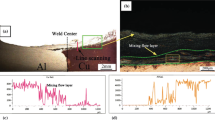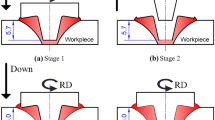Abstract
This paper proposes a heat source model for dissimilar Al/Cu friction stir welding (FSW). First, tool torques of various welding parameters are real-time monitored and then analyzed for plunging, dwelling, welding and cooling stages of the FSW process. Second, total heat input is obtained based on the measured tool torque and is utilized to establish a combined heat source model of the four stages during Al/Cu FSW. In the model, heat distribution on the shoulder and the pin is regarded as planar and volumetric heat flux, respectively. Finally, the temperature distribution and evolution in dissimilar Al/Cu FSW are calculated by developing a numerical model, and the results are found to be in good agreement with the experimental observations. The present work avoids the complexity of determining different contact variables at the tool-workpiece interface and also provides an effective method for a quick prediction of the thermal responses during the full process of dissimilar materials FSW.















Similar content being viewed by others
References
Mishra RS, Ma ZY (2005) Friction stir welding and processing. Mater Sci Eng R 50:1–78
Meng X, Huang Y, Cao J, Shen J, dos Santos JF (2021) Recent progress on control strategies for inherent issues in friction stir welding. Prog Mater Sci 115:100706
Frigaard Ø, Grong Ø, Midling OT (2001) A process model for friction stir welding of age hardening aluminum alloys. Metall Mater Trans A 32A:1189–1200
Schmidt H, Hattel J, Wert J (2004) An analytical model for the heat generation in friction stir welding. Modell Simul Mater Sci Eng 12:143–157
Hamilton C, Dymek S, Sommers A (2008) A thermal model of friction stir welding in aluminum alloys. Int J Mach Tools Manuf 48:1120–1130
Buchibabu V, Reddy GM, De A (2017) Probing torque, traverse force and tool durability in friction stir welding of aluminum alloys. J Mater Process Technol 241:86–92
Nandan R, Roy GG, Lienert TJ, Debroy T (2007) Three-dimensional heat and material flow during friction stir welding of mild steel. Acta Mater 55:883–895
Nandan R, DebRoy T, Bhadeshia HKDH (2008) Recent advances in friction-stir welding—process, weldment structure and properties. Prog Mater Sci 53:980–1023
Arora A, DebRoy T, Bhadeshia HKDH (2011) Back-of-the-envelope calculations in friction stir welding—velocities, peak temperature, torque, and hardness. Acta Mater 59:2020–2028
Arora A, De A, DebRoy T (2011) Toward optimum friction stir welding tool shoulder diameter. Scripta Mater 64:9–12
Chen G, Li H, Wang G, Guo Z, Zhang S, Dai Q, Wang X, Zhang G, Shi Q (2018) Effects of pin thread on the in-process material flow behavior during friction stir welding: a computational fluid dynamics study. Int J Mach Tools Manuf 124:12–21
Huang Y, Xie Y, Meng X, Li J, Zhou L (2019) Joint formation mechanism of high depth-to-width ratio friction stir welding. J Mater Sci Technol 35:1261–1269
Zhai M, Wu CS, Su H (2020) Influence of tool tilt angle on heat transfer and material flow in friction stir welding. J Manuf Process 59:98–112
Khandkar MZH, Khan JA, Reynolds AP (2003) Prediction of temperature distribution and thermal history during friction stir welding: input torque based model. Sci Technol Weld Joining 8:165–174
Colligan KJ, Mishra RS (2008) A conceptual model for the process variables related to heat generation in friction stir welding of aluminum. Scripta Mater 58:327–331
Qian JW, Li JL, Xiong JT, Zhang FS, Li WY, Lin X (2012) Periodic variation of torque and its relations to interfacial sticking and slipping during friction stir welding. Sci Technol Weld Joining 7:338–341
Su H, Wu CS, Pittner A, Rethmeier M (2014) Thermal energy generation and distribution in friction stir welding of aluminum alloys. Energy 77:720–731
Bufffa G, De Lisi M, Sciortino E, Fratini L (2016) Dissimilar titanium/aluminum friction stir welding lap joints by experiments and numerical simulation. Adv Manuf 4:287–295
Zuo DQ, Cao ZQ, Cao YJ, Huo LB, Li WY (2019) Thermal fields in dissimilar 7055 Al and 2197 Al-Li alloy FSW T-joints: numerical simulation and experimental verification. Int J Adv Manuf Technol 103:3495–3512
Sundqvist J, Kim KH, Bang HS, Bang HS, Kaplan AFH (2018) Numerical simulation of laser preheating of friction stir welding of dissimilar metals. Sci Technol Weld Joining 23:351–356
Liu X, Chen G, Ni J, Feng Z (2017) Computational fluid dynamics modeling on steady-state friction stir welding of aluminum alloy 6061 to TRIP steel. J Manuf Sci Eng 139:051004
Hernandez CA, Ferrer VH, Mancilla JE, Martinez LC (2017) Three-dimensional numerical modeling of the friction stir welding of dissimilar steels. Int J Adv Manuf Technol 93:1567–1581
Yang CL, Wu CS, Lv XQ (2018) Numerical analysis of mass transfer and material mixing in friction stir welding of aluminum/magnesium alloys. J Manuf Process 32:380–394
Yaduwanshi DK, Bag S, Pal S (2016) Numerical modeling and experimental investigation on plasma-assisted hybrid friction stir welding of dissimilar materials. Mater Des 92:166–183
Patel NP, Parlikar P, Dhari RS, Mehta K, Pandya M (2019) Numerical modelling on cooling assisted friction stir welding of dissimilar Al-Cu joint. J Manuf Process 47:98–109
Su H, Wu CS, Pittner A, Rethmeier M (2013) Simultaneous measurement of tool torque, traverse force and axial force in friction stir welding. J Manuf Process 15:495–500
Yi D, Onuma T, Mironov S, Sato YS, Kokawa H (2017) Evaluation of heat input during friction stir welding of aluminium alloys. Sci Technol Weld Joining 22:41–46
Schmidt H, Hattel J (2005) Modelling heat flow around tool probe in friction stir welding. Sci Technol Weld Joining 10:176–186
Xue P, Xiao BL, Ma ZY (2015) Effect of interfacial microstructure evolution on mechanical properties and fracture behavior of friction stir-weled Al-Cu joints. Metall Mater Trans A 46A:3091–3103
Zhang H, Sun S, Liu X, Song J, Chen X (2022) Effect of tool-workpiece relative position on microstructure and mechanical properties of Al-Cu dissimilar friction stir weld. J Mater Eng Perform 31:2457–2465
You J, Zhao Y, Dong C, Miao S, Liu Z, Liu L, Su Y (2022) Microstructural evolution and mechanical properties of the Al–Cu dissimilar joint enhanced by stationary-dynamic shoulder friction stir welding. J Mater Process Technol 300:117402
Funding
The authors are grateful to the financial support from the National Natural Science Foundation of China (Grant Nos. 52005297 and 52035005) and the Key Research and Development Program of Shandong Province (Grant No. 2021ZLGX01).
Author information
Authors and Affiliations
Contributions
HS: conceptualization, software, writing—original draft, writing—review and editing, project administration, funding acquisition. JC: methodology, investigation, supervision. CW: writing—review and editing, supervision, funding acquisition.
Corresponding author
Ethics declarations
Conflict of interest
The authors declare no competing interests.
Additional information
Publisher's Note
Springer Nature remains neutral with regard to jurisdictional claims in published maps and institutional affiliations.
Rights and permissions
Springer Nature or its licensor (e.g. a society or other partner) holds exclusive rights to this article under a publishing agreement with the author(s) or other rightsholder(s); author self-archiving of the accepted manuscript version of this article is solely governed by the terms of such publishing agreement and applicable law.
About this article
Cite this article
Su, H., Chen, J. & Wu, C. A heat source model for dissimilar Al/Cu friction stir welding process based on tool torque measurement. Int J Adv Manuf Technol 130, 4621–4634 (2024). https://doi.org/10.1007/s00170-024-12954-9
Received:
Accepted:
Published:
Issue Date:
DOI: https://doi.org/10.1007/s00170-024-12954-9




